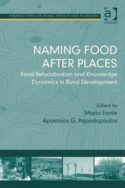
ABOUT THIS BOOK
PUBLISHER: Taylor & Francis Ltd
FORMAT: Electronic book text
ISBN: 9780754694366
RRP: £70.00
PAGES: 306
PUBLICATION DATE:
November 1, 2010
BUY THIS BOOK
As an Amazon Associate and Bookshop.org affiliate we earn from qualifying purchases.
Naming Food After Places: Food Relocalisation and Knowledge Dynamics in Rural Development
Maria Fonte
Apostolos G. Papadopoulos
Professor Henry Buller
Professor Owen Furuseth
Professor Andrew W. Gilg
Bringing together a range of case studies from Ireland, Scotland, Sweden, Germany, Norway, Poland, Italy, Portugal, Spain, and Greece, this book compares and contrasts different models of food re-localization. The richness and complexity of the international case studies provide a broad understanding of the characteristics of the re-localization movement, while the analysis of knowledge forms and dynamics provides an innovative new theoretical approach.Each of the national teams work on the basis of an agreed common framework, resulting in a strongly coherent and comprehensive continental overview. This shows how the actors involved are pursuing their objectives in different regional and national contexts, re-embedding, socially and ecologically, the relation between food production, consumption and places.
Reviews of Naming Food After Places: Food Relocalisation and Knowledge Dynamics in Rural Development
'The book is one of the most succesful attempts of the last years to highlight the relevance of local resources to strategies of sustainable rural development for Europe. While it provides a sound and innovative theoretical framework, the book shows an impressive amount of empirical evidence, covering countries and regions often neglected in the international literature.'Gianluca Brunori, University of Pisa, Italy'Naming Food After Places has two main strengths. First, intrinsically important case studies are brought together within an integrated framework and a common set of questions. Second, each of the local food initiatives is contextualized by reference to history, the current institutional-economic framework, and the specific agroecology of the region. Selections from the book may be assigned for courses in the sociology of agriculture, food, and science to think through the smaller and bigger questions that concern students of food and rural development.' Gastronomica
Maria Fonte
Maria Fonte is Associate Professor in the Department of Economics at the University of Naples Federico II, Italy and Apostolos G. Papadopoulos is Associate Professor in the Department of Geography at the Harokopio University of Athens, GreeceMaria Fonte, Hilary Tovey, Rosemary Siebert, Lutz Laschewski, Lorna Dargan, Edmund Harris, Karl Bruckmeier, Isabel Rodrigo, Jose Ferragolo da Viega, Tomasz Adamski, Krzysztof Gorlach, Gunn-Turid Kvam, Almudena Buciega Arevalo, Javier Esparcia Perez, Vicente Ferrer San Antonio, Apostolos G. Papdopoulos.











